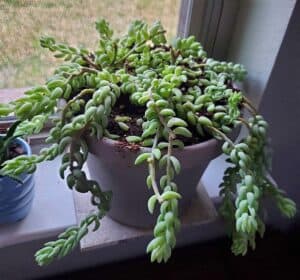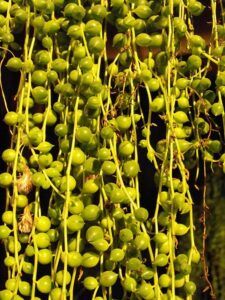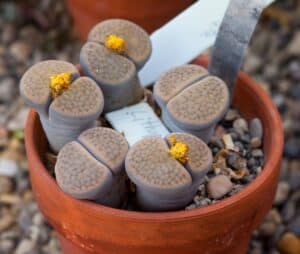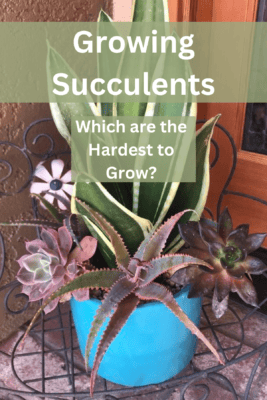This post contains affiliate links.
There are plenty of succulents one would suggest for beginners when asked about what plants are the easiest to grow, but sometimes the question is “What are the hardest succulents to grow”? These plants are for more advanced gardeners since they are either more difficult to care for or require a little more knowledge about their growing conditions.
There are many different kinds of succulents that require an expert’s touch to flourish, and out of those, here are some that can be particularly interesting to learn about.
Some of these we also consider to be some of the easiest succulents to grow (see our article, here) and that is because once you learn how to give them the care they need, they can indeed, be easy to grow… but otherwise, they can be a bit difficult.
Slightly More Difficult: Donkey’s Tail, (Sedum Morganianum)

This is a beautiful, trailing succulent that is perfect for hanging pots, but can be considered to be more difficult to grow, especially for newbies. This plant likes sunshine, but not too much direct sun. It’s a type of sedum and sedums are fairly easy to grow, but what makes this plant a little more difficult to grow than other succulents is that its leaves are so fragile. (It’s best to not move it around much.) It is drought resistant, but does need a little more water than other succulents though the soil needs to be fast draining since it doesn’t like it when the soil is wet too long.
If you want to learn more about growing Donkey’s Tail, we have an article here on Donkey Tail Care and we have included tips on how to successfully grow these trailing succulents.
If you want to grow one, this one from Amazon would be a nice choice.
Slightly More Difficult: String of pearls, ( Senecio Rowleyanus)

These succulents are very popular, but are also a little more difficult ( or trickier) to grow than average. This plant forms strings of green, pearl-like beads that look very nice in hanging pots. They don’t like direct sunshine, but they do need bright light. They need to be in a pot that’s not too big, and they don’t tolerate being overwatered.
If you want them to bloom, they require a period of cold temperatures – but on the other hand, they can’t tolerate temperatures that are too cold. I really believe they aren’t that much more difficult than other succulents, except for the fact that they “really” don’t tolerate too much water. Other than that, once you get used to what your string of pearls plant’s needs are, and how to care for them, you can successfully grow these beautiful plants.
This one on Amazon is a small plant but it would be enough to get you started if you wanted to try growing one of these plants.
More Difficult: Lithops

These succulents resemble rocks or stones and are split in the center; they come in different colors. They are very drought tolerant and because of that, they are sensitive to too much water. Lithops don’t like to be watered at all for long periods of time and require no water at all when they are dormant (fall to spring). That is why they can be considered more difficult to grow- since all too often, people water them when they shouldn’t and the plants end up with root rot. It is also listed as one of the easiest because if you give it the treatment it needs – don’t overwater it – it can then be very easy to grow.
If you are interested in trying to grow your own Lithops plant, this one can be found on Amazon and would be a good one to start out with since there are actually 10 seedlings in one pot, and it would make an interesting centerpiece in your indoor garden.
More Difficult: Aeonium Kiwi
This succulent has a more delicate appearance than the others already mentioned here. The leaves are formed into rosettes and are usually green and are edged with red– but there are other color combinations too, making them an interesting choice for gardeners. This plant is one that many people have found to be difficult to grow. The main reason is that Aeonium Kiwis’ growing habits are slightly different than other succulents.
They don’t like very hot weather or too much direct sun. They require more water during their growing season and very little during their dormant season. Unlike many other succulents, their growing season is in the fall and winter and they are dormant in the spring and summer. Once you realize this – it shouldn’t be difficult to grow these succulents after all.
Amazon has a nice selection of these. This one would be a good choice.
More Difficult: Spiral Aloe, (Aloe Polyphylla)
The spiral aloe, is a beautiful plant native to south africa that grows in a spiral pattern. It is considered endangered in its original habitat which is in South Africa, so make sure your source of plants or seeds is reputable.
Not only are they rare and hard to find, but they are also sensitive about everything and are most certainly not an easy plant to keep alive.
This succulent has specific growing requirements that make it difficult to grow. It is sensitive to environmental requirements such as temperature, watering, sun and humidity. The soil needs to be slightly acidic and well draining. It is drought tolerant so it doesn’t need lots of water,and will easily get root rot if watered too much – this is one main reason it often doesn’t survive. It doesn’t like extreme temperatures or wind, and prefers mild temperatures and dry conditions. This plant is expensive to buy, so If you make a mistake, it can be a costly mistake.
Most Difficult: Pseudolithos Mccoyi
Pseudolithos mccoyi is a very tiny succulent that is extremely hard to grow and one of the hardest to keep alive. This plant is only a few centimeters in size (between 2-8 cm) and is native to Oman in Western Asia. It is also slow growing. This plant has grey-colored stems that look almost reptilian in appearance. The stems have four sides that are ridged.
Some of the reasons it is so difficult to grow is that it requires a 100% mineral soil, it is touchy about its positioning in the soil. It needs regular watering but then it also very easily develops root rot. Additionally, it needs ventilation, as well as sun (but not too much sun) or it will not survive. It is also pretty expensive to buy, so any mistake you make will be a costly learning experience.
Most Difficult: Snake Head Pseudolithos, (Pseudolithos Caput-viperae Lavrano)
The snake head pseudolithos, is also called the viper’s head. That name is due to its resemblance to a viper’s head sticking out of the ground (with the rest of its body buried). It is native to Somalia. It has a warty appearance and ranges in color from a light green to an olive green with hints of reddish-brown. The stem is 2 cm tall to 1.5-6 cm -6 cm long and is oval in shape (giving it that snake-head appearance).
This plant, along with the one mentioned above, Pseudolithos Mccoyi, are perhaps the most difficult succulents to grow and for the same reasons: it needs a 100% mineral soil, it’s touchy about its positioning as well as the same sun, water and ventilation requirements as for the P. Mccoyi. It is also pretty expensive to buy so this is one plant you don’t want to grow if you are a beginner gardener.
This post was written for cactus-central.com and is not permitted to be used on other sites.

